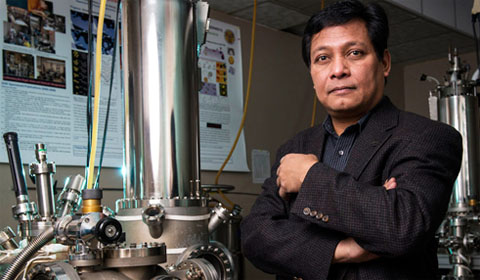
Dr. Martin Kordesch
By Amanda Biederman
NQPI editorial intern
Ohio University Professor of Physics & Astronomy and Nanoscale & Quantum Phenomena Institute member Dr. Martin Kordesch recently received a grant from the Defense Advanced Research Projects Agency to study the fundamental properties of surfaces of thermionic cathodes.
Thermionic cathodes are electron sources in high power high frequency amplifiers. They are used in microwave ovens, older tube television sets, and newer technologies such as the 2006 Pluto satellite “New Horizons.” Kordesch said it has long been known that the cathodes in such instruments operate at a lower temperature (850 vs. 2000°C), using coatings of barium oxide and scandium oxide on the emitter’s tungsten surface. However, researchers do not know why this is the case.
Kordesch said many researchers believe that the compounds form a thick layer over tungsten, while others believe the compounds form a “dipole layer” of approximately one-quarter layer thickness. Kordesch’s group examines the molecular interactions in experimental model cathodes, rather than the entire system. This gives him the advantage of viewing the components of the surface directly, which is otherwise difficult at high temperatures.
Kordesch said his work directly contradicts the “layer theory.” Viewing images at high temperatures through an electron microscope, Kordesch has observed the formation of “beads” on the tungsten surface, like water droplets on a newly waxed car. Kordesch’s group arranges the two layers of oxide molecules in various shapes on the surface, observing their properties both separately and at points in which they overlap. They have found that when the surface is heated, “empty spaces” develop around the coating. This indicates that the compounds are clustering together. Clustering of the molecules is a phenomenon called “dewetting.”
“Wherever (scandium oxide and barium oxide) were touching, they desorb,” Kordesch said. “But wherever they weren’t touching, they stay intact…. This contradicts everything that anybody knew.”
Kordesch hypothesizes that the scandium mediates the dewetting effect. Currently, he is analyzing the behavior of these molecules on single crystal surfaces, to reduce the complexity of the observations. These studies will help him better characterize dewetting among these molecules. Kordesch said his work is addressing an age-old, long-abandoned question.
“Sometimes people give up on the really hard problems because they’re so tough, and move onto lower-hanging fruit,” Kordesch said. “This is a tough problem that’s been left over for a long time.”



















Comments